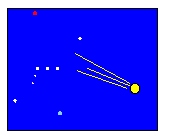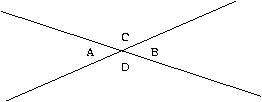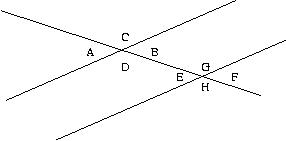 |
Astronomy 101
All the Math You'll Need to Know |
 |
While this is not an aggressively mathematical course, mathematics is
the language of science, and we can't talk about astronomy without
using mathematical relationships. The good news here is that none of
the mathematics you will see in this course should be new to you; it's
all stuff that you encountered in high school. However, I realize that
seeing it once in your distant past doesn't mean you remember it now,
so this little page is a gentle reminder of some of the basic
concepts.
Algebra
Solving Equations -- This is simply a question of moving around
the terms in an equation until you get what you want on the left side
and what it equals on the right side. If you can solve the following
equation,
then you can do Algebra. All you need to do here is divide both sides
of the equation by 2, yielding,
- x = 7/2
or equivalently,
- x = 3.5.
That's really all there is to it. Sometimes the equations are a bit
more involved, but as long as you multiply, divide, add or subtract
the same quantities on both sides of the equation, things should work out.
So an equation like,
- 3x + zy2 = 14
will solve as
- x = 14/3 -zy2/3.
You can play the same game with variables, so
yields for m,
What did I do here? I just multiplied both sides by R, divided both
sides by G, and then divided both sides by m. Lastly, I switched the
left side for the right side so that I ended up with an "m = " format.
Sometimes the quantity you're looking for is squared or cubed, i.e.,
Here we can use the same manipulations to get
but then we need to take the square root of both sides to get the answer
where "Sqrt()" means "take the square root of whatever's inside the
parentheses." In each of these cases, the rule is always the same --
whatever you do to an equation, do it to both sides of the equation
and the resulting equation will still be correct.
Geometry
Most of geometry is codified common sense. Here's an example:

Where two straight lines cross, the "opposite angles" are equal. If
you just stare at the figure for a minute, you'll realize that this
has to be so. If it weren't true, one of the lines would have
to be crooked. Therefore, A=B and C=D.
A variant on this is the old "line crossing a pair of parallel lines" rule:

If the two lines running from lower left to upper right are parallel,
then the line crossing these parallel lines must make the same angles
with each one. Based on that logic, A=B=E=F, and C=D=G=H.
Right angles are special angles, and you should know that a right
angle is a 90 degree angle.

So in the figure above, A = 90. Moreover, if a right angle is broken
into two angles as in right-hand panel in the figure above, these two
angles must sum to 90 degrees, i.e., B + C = 90 degrees.
The same logic can be applied to a set of angles that span the "angle"
made by a straight line.

So, in the above diagram, D+E+F=180 degrees, or E+F= 180-D, or F =
180-D-E, or, well, you get the idea.
Trigonometry
I wish trig didn't have such a nasty-sounding name, because it's
really not that complicated at all. It's nothing more than a few
simple relationships between the angles and the lengths of the sides
of a right triangle. A right triangle is a triangle with one right
angle (since the sum of the angles in a triangle equals 180 degrees,
there's no way to have more than on right angle in a
triangle). Consider the right triangle below, where the right angle is
at the left.

I've just picked one of the two non-right angles in the triangle and
labeled it C. I've also labeled the lengths of each of the triangle's
sides with lower case letters:
"o" for the side opposite the angle C,
"a" for the side adjacent to C, and
"h" for the "hypotenuse," which is
the side opposite the right angle (it's also the longest side in the triangle).
The trig identities just relate the angle C to combinations of the
lengths of the sides, so
- sin(C) = o/h (i.e., the length of the opposite side divided by the length of the hypotenuse)
- cos(C) = a/h
- tan(C) = o/a
You can find the sin(), cos(), and tan() functions on your calculator,
and use them to determine the ratios between different lengths of the
triangle. This is really useful because it provides a way to relate
angles to lengths (for example, if you know the angle
and one of the lengths, you can get the other length). We'll deal a
lot with angles in this course ('cuz that's pretty much all we can
really measure in astronomy), and trig will provide us with a way to
figure out lengths and sizes of astronomical objects.
One last note -- be careful about the units of your angles. Most
calculators have a switch that allows you to takes sin's and cos's of
angles in either degrees units or radian units. For this course, it
will be most useful if you stick to degree units, and therefore you
should set your calculator to accept angles in degrees. Here's a way
to test that your calculator is doing things right: calculate the sin
of 90 degrees. It should be 1, but if you come up with some other
number, your calculator is probably thinking you want the sin of 90
radians.
Scientific Notation
The numbers in astronomy or aften so huge that writing them out
conventionally would take up way too much space (e.g., the distance
from the Earth to the Sun is 150000000000 km). This is why astronomers
use scientific notation to express these huge numbers more compactly.
I won't write more about this here because your textbook (p. 541) does a
pretty nice job with it. Please take a look at that description is
you're uncomfortable interpreting numbers like
Note that some calculators display this number as "1.7e+05" where the
"e+05" means "105." Even if you're comfortable with this
kind of notation, please make sure you can interpret your calculator's
output before you need it on a problem set or exam.








